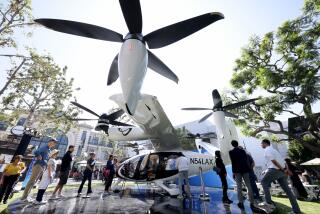City Council Grounds Plan to Build Ultralight Airfield
Plans to build a landing strip for ultralight aircraft in the city’s San Pasqual Valley agricultural preserve were shot down by the San Diego City Council Wednesday.
The aircraft, which resemble hang gliders with engines and sound like a swarm of killer bees, are becoming increasingly popular with sports enthusiasts but increasingly unpopular with neighbors of the planes’ playgrounds.
George Evangelou, operator of an ultralight field near Lakeside, sought San Diego’s permission to establish another one in the San Pasqual area on 20 acres of the 1,450-acre ranch William Witman leases from the city. He said the small planes are safe and not that noisy. Their 50-horsepower engines are considerably less noisy than crop-dusters, he argued.
But according to Bill Knowles of the city Property Department, valley farmers and dairymen, residents on the hillsides and officials of the Wild Animal Park don’t want the planes in their valley scaring cows, waking up napping babies and disturbing the natural habitat the Wild Animal Park has sought to create for its exotic animals.
Knowles recommended to members of the council’s Public Facilities and Recreation Committee that they turn Evangelou down and keep peace in the valley. Council members complied, by a 5-0 vote, but Councilman Bill Cleator left the door ajar for Evangelou by telling him: “If you think it’s been a rigged deal, you can come back with the facts and we could reconsider our decision.”
Can’t Land at Airports Evangelou said that the increasing popularity of the mini-planes among San Diegans has increased the problems for owners of the light craft. Federal Aviation Administration rules don’t cover them. Most airports won’t let them land. It sometimes seems, he said, that only their owners want the ultralights around.
By 1990, Evangelou said, the number of ultralights in the county will grow into the thousands. Citing a study by the San Diego Assn. of Governments (Sandag), he said that “as many as 20 landing sites will be needed by 1990” to accommodate the craft if their numbers continue to increase. (The Sandag study estimates that by the year 2005, San Diegans will own 930 to 2,221 ultralights compared to the 300 owned by county residents in 1984. Twelve to 28 landing sites would be needed to accommodate the ultralights by 2005, it concludes.)
“It’s absolute nonsense to say we would disturb people in the valley (which lies between Rancho Bernardo and Escondido),” Evangelou told reporters after his unsuccessful attempt to win approval of his San Pasqual airstrip lease. “We have never had a formal complaint against us.”
The little craft provide an inexpensive way to fly, he said, and the ultralights couldn’t be safer. In case of power failure, they can drift to the ground or the pilot can deploy a parachute to bring both the craft and its occupant safely and slowly to earth, Evangelou explained.
Farmers’ Fears Doubted Dairy farmers’ concerns that their herds will give less milk with the ultralights buzzing around are of doubtful validity, he said. And Evangelou questioned the opposition of Wild Animal Park officials, pointing out that the tourist attraction hired an ultralight pilot to perform twice-daily air shows over the park until about two years ago.
Evangelou was surprised by the opposition to his proposal because the city’s own Agricultural Advisory Board had recommended that the city allow a one-year test of the ultralight airstrip.
Knowles said he was surprised by the advisory group’s recommendation but not by the opposition of the San Pasqual Agricultural Assn., the San Pasqual-Lake Hodges Planning Group or the Wild Animal Park.
“This is a totally unregulated business,” Knowles said, “and the people out in the valley feel that sooner or later there will be problems.”
Evangelou pledged to explore the valley dwellers’ concerns and to attempt to enlist their support for the ultralight airfield, although, he said, the rural residents tend to display “animosity toward outsiders.”
More to Read
Sign up for Essential California
The most important California stories and recommendations in your inbox every morning.
You may occasionally receive promotional content from the Los Angeles Times.










